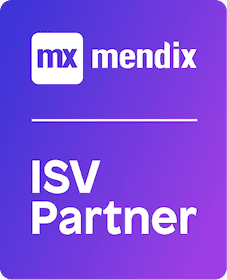Navigating Digital Transformation:
Choosing the right path for your business.
Ever feel like your business app ideas are stuck in traffic? Traditional coding processes can leave you waiting at a red light for months, yearning for that game-changing application. Complex code, lengthy development cycles, and reliance on specialized developers can put a serious damper on your innovation.
Traditionally, IT teams spent countless hours writing lines of code to translate business ideas into user-friendly software. This process, however, while effective, could be slow and resource-intensive. What if there was a faster, more accessible way to build the apps your business needs?
Enter low-code development – a revolutionary approach that’s streamlining the app creation process. Could this be the right turn for your company?
A recent Gartner survey predicts that by 2025, a whopping 70% of new applications will be built using low-code platforms. While traditional coding will always have its place, businesses now have more options than ever. To help you decide which approach is best for your company, let’s explore the key differences between low-code and traditional development.
Low-Code vs. Traditional Coding: What’s the Difference?
Choosing the right development approach can be the difference between a market-leading innovation and a frustrating roadblock. Here are the key differences between these two approaches, so you can select the optimal gear for building your next business app.
Coding Intensity
Traditional coding is a deep dive, requiring developers to write line after line of code using specific programming languages. Low-code, on the other hand, prioritizes user-friendly interfaces with drag-and-drop functionality and pre-built components. This allows for quicker development even with minimal coding experience.
Team Composition
Traditional coding typically requires a dedicated pit crew of professional developers. Low-code platforms empower “citizen developers” – business users with minimal coding knowledge – to get behind the wheel and actively participate in building applications. This can streamline communication and bridge the gap between business needs and technical execution.
Development Speed
Traditional coding can be a long, winding road, especially for complex projects. Low-code development boasts faster acceleration due to pre-built functionalities and streamlined workflows. This allows you to adapt and iterate on your software solutions more quickly, keeping you ahead of the curve.

What are the advantages of low-code development?
Low-code development platforms (LCAPs) are revolutionizing the way businesses build applications. While traditional coding offers granular control, low-code emphasizes focus on efficiency and accessibility. Here’s how low-code development empowers your business to build better apps, faster:
Empower Talents
Low-code platforms democratize development, meaning even users with minimal coding experience can contribute. This visual approach with drag-and-drop functionality and pre-built components accelerates development for professional developers and empowers “citizen developers” to build simple applications.
Boost Productivity Across Teams
Pre-built components and reusable elements like modules, logic templates, and connectors fast-track development. This frees up specialized developers to focus on complex tasks, maximizing their expertise.
Foster Collaboration
Built-in collaboration tools like feedback loops, revision tracking, and messaging bridge the gap between business and IT. The visual nature of low-code ensures everyone speaks the same development language, and this fosters better communication and cross-functional decision-making.
Embrace Agility and Scalability
Low-code platforms are cloud-based, allowing for rapid deployment of new applications and easy scaling of existing ones. This flexibility keeps your organization agile in the face of changing market demands and business needs.
Effortless Data Integration
Securely connect data and logic from any source, system, or service, including legacy systems. Pre-built APIs and connectors simplify integration, while skilled developers can still build custom solutions. This reduces development time and allows you to leverage existing data more effectively.
Streamlined Application Lifecycle Management
Low-code platforms automate several key phases of development, from project management and requirements gathering to version control and deployment. This Agile approach with built-in DevOps tools keeps projects moving smoothly and accelerates delivery.
In essence, low-code development goes beyond just speed. It empowers your business to build better applications faster, leverage a wider range of talent, and remain agile in a dynamic market.
What is Mendix and how does it differ from traditional app development?
Mendix is a frontrunner in the low-code application development platform (aLP) space. Since 2005, they’ve been empowering businesses to develop applications at an accelerated pace with their cutting-edge, visual approach.
Imagine building software with drag-and- drop functionality and pre-built components instead of lines of code – that’s the core idea. This allows even business users with minimal coding experience to collaborate alongside professional developers, potentially through trusted Mendix partners like Rapid App Werks. This teamwork can lead to faster development cycles and potentially lower costs for businesses.
How do I choose between low-code and traditional software development?
Now that you’ve got a roadmap of the core differences, how do you decide which approach aligns best with your business goals? Here are some key factors to consider:
Project Complexity
For highly intricate applications with unique features, traditional coding offers the ultimate level of control and customization. However, for simpler applications or internal tools, low-code’s pre-built components can be a time-saving shortcut.
Technical Expertise
If your in-house team has a team of seasoned mechanics – programmers with a strong background – traditional coding might be a natural fit. But if you lack experienced developers, low-code’s user-friendly interface can empower your business users to contribute to the development process.
Budget
Traditional coding requires a team of experienced developers, whose salaries and potential project overruns can significantly impact the bottom line.
Low-code development, on the other hand, is typically more budget-friendly for several reasons. First, it often utilizes subscription-based pricing, offering more predictable costs compared to traditional developer salaries. Second, by reducing development time – a key benefit of low-code – you inherently reduce labor costs associated with the project. This makes low-code a compelling option, especially for projects with tighter budgets.
Need for Speed
If you have a tight deadline and need a functional application quickly, low-code development’s faster turnaround times might be more preferrable for your business.
Launch Your App 10x Faster with Rapid App Werks
Low-code and traditional coding aren’t necessarily rivals – they can exist on a highway with multiple lanes. Ultimately, the best approach depends on your unique needs and resources. By carefully evaluating your project’s complexity, technical expertise, and budget constraints, you can choose the development path that moves your business forward, keeping you agile and competitive in your industry. If you need results fast at reduced costs, low-code development is the way to go.
Ready to turn your ideas into reality with low-code development?
Rapid App Werks can help you achieve your goals dramatically faster and more efficiently. Leveraging the power of Mendix, our team will transform your vision into a real-world application in record time.
Contact Rapid App Werks today for a free consultation and see how low-code development can revolutionize your business.


